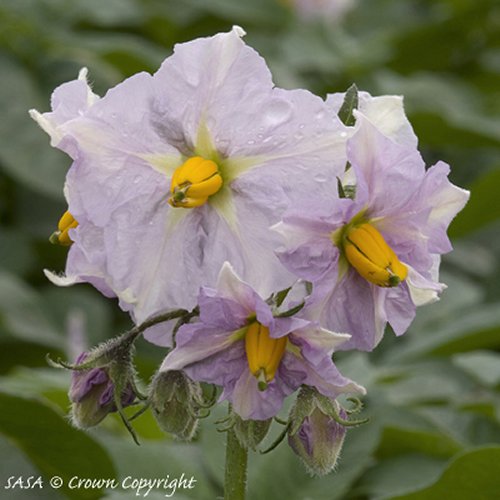Harvesting potatoes is one of the great joys of vegetable gardening. Knowing when to start harvesting them is a key factor. If you have followed our chitting and planting times for seed potatoes:
If you have deviated from our recommended chitting or planting timings, you can assume the following:
Some people may advise that a good time to harvest potatoes is when they flower. This is not a good idea. Firstly, many potato plants do not produce any flowers at all, others only produce so few that the event may be missed.

Charlotte Potato Plant Flower
Secondly, the production of flowers by potato plants can vary significantly year by year, with no relationship as to when the potatoes are ready for harvest.
One thing you can be sure of, if the foliage starts to die down, for whatever reason, then the potatoes below ground will not mature further so you might as well harvest them.
However do remember that many second early varieties and almost all maincrop varieties can remain in the ground for several weeks after the recommended harvest dates with little or no degradation in flavour and texture.
One warning though about the above paragraph is that the longer the time the potatoes remain in the ground, the more likely they are to suffer from pests (slug damage especially) and diseases.
The exception to the above is that potatoes grown in containers will last longer (especially less slug damage) in the container compost compared to potatoes grown in open ground.
Potatoes grown in containers can be harvested with your hands in almost all conditions, however potatoes grown in open ground should be harvested on a dry day. This will allow most of the soil to fall off the potatoes when you harvest them.
It will also allow the harvested second early and maincrop potatoes to be placed on the relatively dry soil surface for a day or so to slightly hardened the surface of the potatoes. First early (new) potatoes can be taken inside immediately they are dug up.
Dig a fork into the ground, roughly 45cm (18 ins) away from the centre of the plant and gently move it around to loosen the surrounding soil. You should then be able to harvest the potatoes using your hands and possibly a trowel.
Gently brush the potatoes with your hands (never wash with water) to remove the excess soil. Ideally (for Second Early and Maincrop varieties) leave the potatoes on the soil surface for a day or so. This will slightly harden the skin and enable them to store for longer.
The best conditions for storing potatoes are cool (but definitely frost free) conditions (ideally around 8 C / 47 F), in the dark and with low levels of moisture. They should be stored so they are not touching each other and allowing free air flow.
Use paper bags or special potato bags, never plastic bags which will trap too much moisture. Another essential is to keep them in the dark to reduce the possibility of the potatoes sprouting.
Potatoes should only be stored when they are in good condition, potatoes in poor condition will almost certainly infect others next to them.
A garage or cool larder is a good place to sore potatoes. At a pinch, use the top shelf of your fridge. The top shelf will be nearer the ideal temperature compared to the lower shelves.
IF YOU HAVE ANY QUESTIONS OR COMMENTS
CONCERNING THIS PAGE, ENTER THEM BELOW.
WE WILL ANSWER ON
THIS PAGE AS SOON AS POSSIBLE